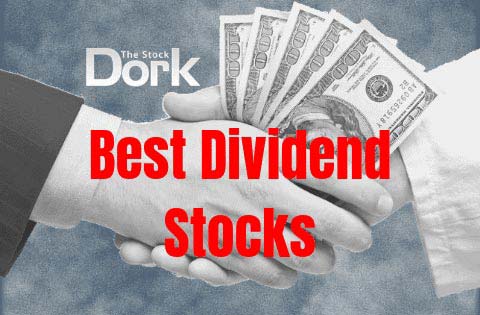Top-5 Dividend Stocks to Buy Now
During uncertain times like these, having some dividend stocks in your portfolio never hurts.
Watching your portfolio jump up and down can be rough on the nerves, but dividend payments offer returns that you can count on.
Getting that extra cash makes it easier to hold on through the volatility and stick to your overall investing strategy.
More Cheap Stocks
If you’re looking for low-priced deals, be sure to check out our hot stock watchlists.
They’re updated monthly with the best stocks under the 1 dollar list, stocks under 5 dollars (source), and stocks under 10 dollars here.
Last but not least, our best penny stocks list has all the hottest cheap stocks.
Best Dividend Stocks 2019
These are the dividend stocks that could be the best long-term plays.
AbbVie Inc. (NYSE: ABBV)
Biotech / Pharma, Yield: 6.54%
AbbVie is a mega-cap biotech firm that is most well-known as the producer of Humira, a biological treatment for various diseases.
Shares are down because the firm’s exclusive patent rights are about to run out, opening the door for competitors to push generic bio-similars and shrink AbbVie’s market share.
However, the market might be oversold on this one.
Humira earns a huge proportion of Abbvie’s earnings and profits, but they also have several promising treatments in the pipeline.
Plus, analysts expect AbbVie’s acquisition of Allergan to close in early 2020 and further reduce the firm’s dependence on its Humira earnings.
Experts project that the company generates enough cash flow to sustain the dividend yield for years to come.
Ford Motor Company (NYSE: F)
Automotive, Yield: 6.59%
It’s been a tough year for the auto sector.
The industry is dealing with regulatory pressures, labor unrest, and tariff threats; just to name a few.
However, Ford looks like it could be a good long-term buying opportunity for dividend investors.
Management is cutting out unprofitable areas of the business and making operational changes to reduce costs and increase manufacturing flexibility.
This company is headed in the right direction, and the board is committed to maintaining the dividend.
This is the kind of stock you buy and hold for a long time, but you may want to wait until 2020 to jump in.
China is scheduled to impose 25% tariffs on American auto imports starting in December.
However, a last-minute truce could be a positive catalyst for share prices.
Lloyds Banking Group PLC (NYSE: LYG)
(United Kingdom) Financial, Yield: 4.64%
If you follow stock market news, you’ve probably heard about the incredible value numbers in European bank stocks.
A looming global slowdown and a glut of negative-yielding European sovereign debt are turning the Street bearish on old-world financial stocks, but the value ratios are eye-catching, to say the least.
As a British bank, Lloyds is facing a lot of uncertainty with Brexit, but the firm restructured its operations in preparation for a potential crash-out and is now well situated for a no-deal Brexit.
In terms of regulatory cost risk, it looks like the worst is over for Lloyds.
If you can ride out the Brexit volatility, the long-term outlook for this bank stock is bullish.
Royal Dutch Shell PLC (ADR: RDS/A)
(United Kingdom) Oil/Gas Energy, Yield: 6.80%
Oil and gas is a tough sector to turn a buck these days, but you can find some great long-term values amongst the losers.
Shell boasts one of the worlds’ largest LNG portfolios, plus lucrative refining & chemical businesses.
The LNG market is incredibly over-supplied at the moment, but the demand for LNG is projected to rise in the coming years, which could help fuel price growth.
The refining segment gives the company a steady revenue source to fall back on in case oil prices continue to fall.
Shell adjusted its business model to reduce costs in order to compete under lower oil prices.
If oil recovers to $65 a barrel, a conservative projection, the company should generate as much as $25 billion in free cash flow.
Those three factors make a strong case for Shell recapturing its 52-week high of $70 per share in the future.
That’s over 27% of upside from its current price levels.
AT&T Corp. (NYSE: T)
Telecommunications & Media, Yield: 5.77%
After floundering around $29 per share for most of the year, AT&T is finally starting to make its move.
Telecom stocks usually make good defensive allocations, and AT&T’s 5.7% dividend sweeten the deal.
The company has more media outlets that any of its competitors can match, with direct access to over 170 million pairs of eyeballs across its entire content portfolio.
WarnerMedia has a vast portfolio of intellectual property and the HBO Max streaming service is set to launch soon.
When the HBO Max launches, it will likely be a positive catalyst for the stock.
Don’t forget about AT&T’s consumer cellular business.
It provides lots of steady revenues and is pretty much recession-proof.
With a dividend of over 5.5%, AT&T looks like a long-term winner.
High Yield Dividend Stocks
You can find high paying dividend stocks by using a stock screener, but if it looks too good to be true it probably is.
Beware of ‘yield traps’, high paying dividend stocks that are headed for disaster.
For whatever reason, these companies have long-term issues so they try to suck in investors with attractive yields.
Instead, search for quality companies with sustainable dividend payouts that are higher than the market average.
To determine a good benchmark, the S&P 500 dividend yield is a good place to start.
iShares Core SP500 ETF (IVV) currently has a 1.99% yield ratio, but most companies yield much more than that.
For more perspective on dividend yields, compare them to their industry peers.
The average sector dividend yield gives you another data point that you can use to evaluate a dividend stock.
Dividend Payout Ratio: Explained
Dividend payout measures the what percentage of overall earnings a company distributes through dividends.
Ratios over 100% indicate that a company is paying out more than it’s earning, so it will either have to earn more money or cut its dividend moving forward.

However, a low ratio isn’t good either. It implies that a company isn’t very committed to returning money to shareholders.
That isn’t necessarily a bad thing. Some companies are focused more on growing revenues than returning earnings to shareholders.
Do your due diligence and judge for yourself if the company’s dividend policy aligns with your own.
Generally, experts view dividend payouts between 35% and 75% as the ‘sweet spot’.
Monthly Dividend Stocks
Most dividend stocks payout every quarter or every six months, but some dividend stocks payout monthly.
Income investors love monthly dividend stocks because monthly payments provide more flexible cash flow.
Most stocks that pay monthly are ETFs. In particular, many bond fund ETFs make monthly payments, like the iShares High-Yield Corporate Bond Fund (HYG).
If you like more regular cash flow from your portfolio, you may want to look into monthly dividend stocks.
Dividend Stocks: How to Buy
After seeing this lineup of the top dividend stocks, you might be looking to buy.
But, finding the highest-yielding dividend stocks is only the first step.
Once you find a trade, you have to find a broker.
You buy and trade dividend stocks like any other stocks and, when dividend payment is made, it will usually post directly to your brokerage account automatically.
If you’re shopping for a broker, check out these Robinhood and WeBull reviews. Both of these firms charge zero commissions and no account fees, so they’re great options for traders with smaller budgets.
How Do Dividend Stocks Work?
In most cases, dividend payments have three phases.
First, the company announces a dividend.
Usually, management announces the dividend during quarterly earnings reports, but sometimes special press releases detail the specifics.
As part of this announcement, the company announces an ‘ex-dividend’ date.
If you’re owning the company’s stock when the session opens on the ex-dividend date, you’re entitled to the dividend.
It doesn’t matter if you sell the stock as soon as the session opens, you’ll still receive the dividend on the payment date.
If you want to clock in for the dividend payment, you need to buy the stock before the close on the day before the ex-dividend date.
After hearing this, you may think, “why not just buy stocks for the ex-dividend date and then sell them?”
It makes sense in theory but not in practice, unfortunately.
Stocks tend to slide on their ex-dividend date and, usually, the underlying exposure to short-term price movements generally negates the benefit of the dividend.
Trust me when I tell you because I learned this lesson the hard way in the early days of my trading career.
I ended up losing 3% of my principle chasing a 2% dividend.
Dividends aren’t for short-term chasing, they’re for long-term investing and steady income.
Best Long-Term Dividend Stocks
Dividend stocks are most effective when held for long periods of time.
They generally best serve the interests of investors who are buying for the long haul. If you want to search for own dividend stocks, start with these screener settings.
- Mid-cap or higher
- Positive earnings growth
- Profitable
- Low-debt
Also, pay attention to the payout ratio. It measures the sustainability of dividend payments.
Anything higher than 75% is a red flag but can be maintained so long as a company continues to grow its earnings, but it doesn’t leave a lot of margin for error if the business encounters cash flow problems.
The sweet spot for dividend payouts is between 35% and 75% of earnings.
Dividend Stocks: Closing Thoughts
In an uncertain economic environment, dividends can be a great way to get returns from your investments.
Bond yields are falling rapidly in the U.S. and they are already negative overseas, so there aren’t a lot of options for yield-seeking investors.
As interest rates drop and yields head lower, expect dividend stocks to be an increasingly important part of the average portfolio in the coming years.


 Tags:
Tags:










